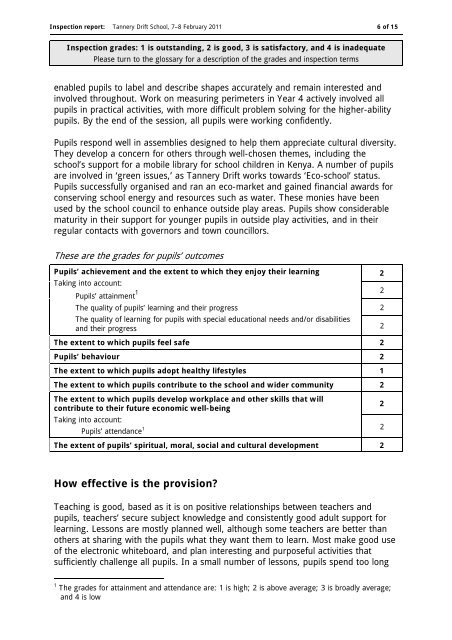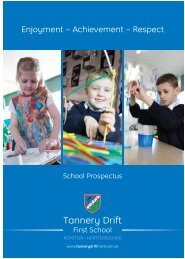Ofsted Report 2011 - Tannery Drift First School
Ofsted Report 2011 - Tannery Drift First School
Ofsted Report 2011 - Tannery Drift First School
- No tags were found...
You also want an ePaper? Increase the reach of your titles
YUMPU automatically turns print PDFs into web optimized ePapers that Google loves.
Inspection report: <strong>Tannery</strong> <strong>Drift</strong> <strong>School</strong>, 7–8 February <strong>2011</strong> 6 of 15<br />
Inspection grades: 1 is outstanding, 2 is good, 3 is satisfactory, and 4 is inadequate<br />
Please turn to the glossary for a description of the grades and inspection terms<br />
enabled pupils to label and describe shapes accurately and remain interested and<br />
involved throughout. Work on measuring perimeters in Year 4 actively involved all<br />
pupils in practical activities, with more difficult problem solving for the higher-ability<br />
pupils. By the end of the session, all pupils were working confidently.<br />
Pupils respond well in assemblies designed to help them appreciate cultural diversity.<br />
They develop a concern for others through well-chosen themes, including the<br />
school’s support for a mobile library for school children in Kenya. A number of pupils<br />
are involved in ‘green issues,’ as <strong>Tannery</strong> <strong>Drift</strong> works towards ‘Eco-school’ status.<br />
Pupils successfully organised and ran an eco-market and gained financial awards for<br />
conserving school energy and resources such as water. These monies have been<br />
used by the school council to enhance outside play areas. Pupils show considerable<br />
maturity in their support for younger pupils in outside play activities, and in their<br />
regular contacts with governors and town councillors.<br />
These are the grades for pupils’ outcomes<br />
Pupils’ achievement and the extent to which they enjoy their learning<br />
Taking into account:<br />
Pupils’ attainment 1<br />
The quality of pupils’ learning and their progress<br />
The quality of learning for pupils with special educational needs and/or disabilities<br />
and their progress<br />
The extent to which pupils feel safe 2<br />
Pupils’ behaviour 2<br />
The extent to which pupils adopt healthy lifestyles 1<br />
The extent to which pupils contribute to the school and wider community 2<br />
The extent to which pupils develop workplace and other skills that will<br />
2<br />
contribute to their future economic well-being<br />
Taking into account:<br />
Pupils’ attendance 1 2<br />
The extent of pupils’ spiritual, moral, social and cultural development 2<br />
2<br />
2<br />
2<br />
2<br />
How effective is the provision<br />
Teaching is good, based as it is on positive relationships between teachers and<br />
pupils, teachers’ secure subject knowledge and consistently good adult support for<br />
learning. Lessons are mostly planned well, although some teachers are better than<br />
others at sharing with the pupils what they want them to learn. Most make good use<br />
of the electronic whiteboard, and plan interesting and purposeful activities that<br />
sufficiently challenge all pupils. In a small number of lessons, pupils spend too long<br />
1 The grades for attainment and attendance are: 1 is high; 2 is above average; 3 is broadly average;<br />
and 4 is low





